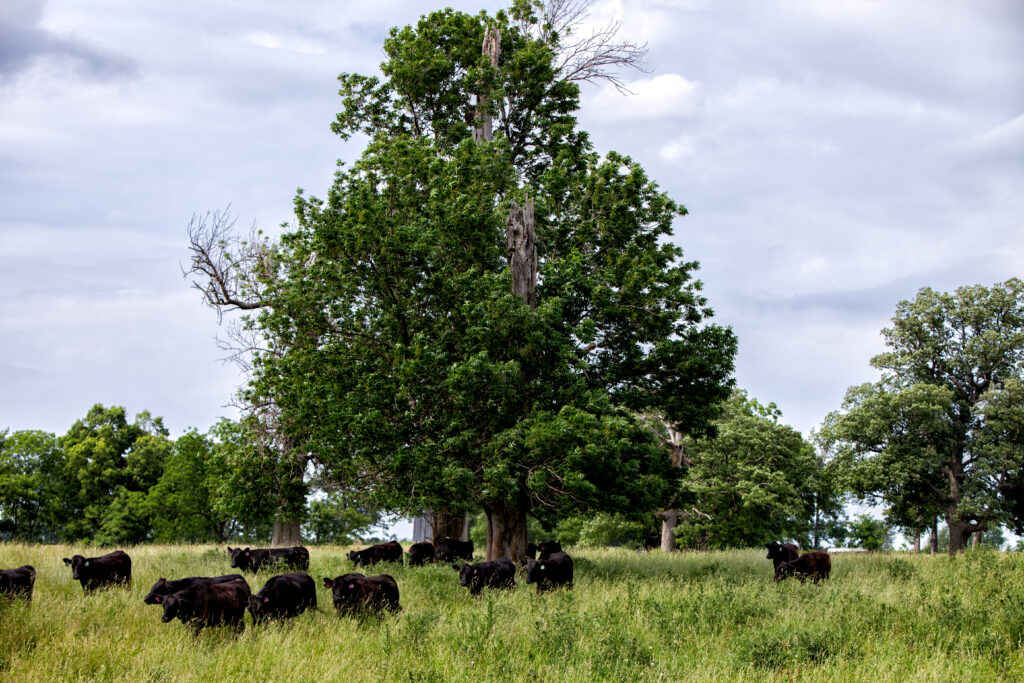To continue last week’s farm tour, walking west away from the lunch area, past the billowy white pines sheltering the homes where ‘the guys’—our farm crew—live, we stop at a plain-looking pasture. Describing this diverse, essential field as plain could not be further from the truth, as you’ll learn.

A flimsy-looking plastic twine drapes from a snakey row of little steel posts along the driveway, keeping us from traipsing off too far, lest we get a jolt. (The innocent-looking plastic twine is actually an electric fence wire.) Humongous, stately, old oak and ash trees stand tall in the field, appearing to hold guard. For half the year, from here you can see an equipment shed north of us in the heifer field, the historic “Elmwood” home and a subdivision off to the west. The other half of the year, you can’t see those buildings, rather trees of all kinds. The greenhouses and tobacco barn-turned-equipment-hub is over our left shoulder to the southeast.
Fields like the one we’re standing by are the workhorses of Elmwood Stock Farm’s regenerative-agriculture model. Not-so-passive solar-energy collectors. Carbon sequestration at its finest. Millions of individual vascular plants, working in unison, photosynthesize solar energy into stored energy and proteins in the form of cellulose and fiber (the forage). These nutrients are then consumed by a passing bovine, making beef to fuel our bodies and nutrients to feed the soil.
The beauty of all this is, with a sound rotational grazing program, the plants actually benefit from the symbiotic relationship they have with beef and sheep. When the grazing animals remove some, or parts, of the leaves from the forage in the field every so often, these plants are stimulated to grow more aggressively, all the while pumping nutrients into the soil for regeneration potential. In our system, we use the animals to build soil and store more potential energy in the form of carbon for five years, when we’ll convert the field to a vegetable garden. We would keep cows at Elmwood Stock Farm for these benefits, even if they didn’t fit into the farm’s product line.
The cattle may actually be the most efficient protein sources on the planet. They feed themselves, plus the complex carbohydrate-based energy in the forage they consume makes for the right kind of fat. When cattle consume high daily doses of readily digestible starches, like corn, it lowers the pH of their digestive system, altering fat metabolism to something not known to Homo sapiens until after World War II, when feeding grains to animals in industrial feedlots came into practice.
The momma cows graze contentedly throughout the grazing season and munch on hay the few months in winter. With a nine-month gestation period, we rebreed the cows while they’re still nursing their last calf to give us offspring each year. The calves nurse for about seven months before we wean them to allow mom time to prepare for her next calf.
The cows we have here now were born here however long ago, as were their mommas and grandmommas, great grandmommas, and on and on. As we have moved into grass-finishing our beef, we have bred them to have smaller bone structure, which correlates with their ability to reach the USDA Choice grade on grass—as opposed to all that corn needed to get a tall and lanky animal fat.
Back to that flimsy little fence: It’s more of an electrified psychological barrier than a physical barrier. A calf is naturally curious and invariably gets shocked as a baby when it reaches out to touch the fence with its nose. Like the elephants they resemble, cows are not stupid—they remember and have no interest in touching the fence again.
With this simple, moveable fence technology, we can make a pasture anywhere, any size we want. This allows us to adjust the space they need so they eat all the grass in three days. The reason for this are internal parasites, a normal presence in these animals. Any internal parasites in the animal will shed their eggs, which hatch in three days. The resulting larvae climb up the blade of grass to get consumed by a grazing animal. A buildup of internal parasites can be debilitating, but if we keep the herd moving, the host cow eventually carries very few and we see no problems. Non-organic beef farmers don’t worry about all that—they simply pour a synthetic insecticide on the back of the animal that systemically moves throughout the body, ridding it of any parasites. Not so appetizing. It’s simple but not easy to avoid such nonsense: Move them every three days, which is good for the grass, too.
To wrap up this tour stop, what you see is essentially solar-powered food production. Sunlight is converted into soil carbon and cellulose, which is captured by a grazing ruminant that feeds itself. All we have to do is control the cattle’s movement from pasture to pasture. (They do that themselves, too. We just open the gate.)
So, that’s the way we provide heart-healthy, grass-fed and -finished, certified organic, USDA Choice, dry-aged Angus beef AND feed the soil that grows our vegetables at the same time.
Questions? Let us know, and let’s keep moving on this farm tour. Next week, we’ll visit the greenhouse and high tunnels.



Made with 
